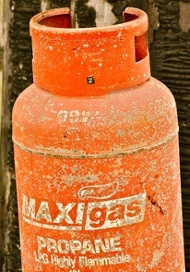Propane in Your Air Conditioner? Bad Idea!

 “A New Zealand technician got fire balled in the face,” a member of the HVAC-talk.com forum stated bluntly. He was referring to a case where an HVAC tech got burned when he thought he was working on a system with R-22 refregerant, which is not flammable, but which instead was filled with propane, which is flammable. Someone switched out the refrigerant but didn’t label the system as now having a flammable refrigerant.
“A New Zealand technician got fire balled in the face,” a member of the HVAC-talk.com forum stated bluntly. He was referring to a case where an HVAC tech got burned when he thought he was working on a system with R-22 refregerant, which is not flammable, but which instead was filled with propane, which is flammable. Someone switched out the refrigerant but didn’t label the system as now having a flammable refrigerant.
“A New Zealand technician got fire balled in the face,” a member of the HVAC-talk.com forum stated bluntly. He was referring to a case where an HVAC tech got burned when he thought he was working on a system with R-22 refregerant, which is not flammable, but which instead was filled with propane, which is flammable. Someone switched out the refrigerant but didn’t label the system as now having a flammable refrigerant.
The latest bad turn in the story on the phase-out of R-22 air conditioner refrigerant is the use of unapproved substitutes for R-22. You can go online and find a lot of them. They have different labels—R-22a, 22-A, HC-22a, CARE 40, and more—and their big advantage is that they’re cheaper than R-22, which has become really expensive because it’s being phased out.
The problems with R-22 substitutes
Their drawbacks far outweigh their benefits, however. The US Environmental Protection Agency this week issued a news release about the dangers of unapproved refrigerants. “EPA is aware of incidents that have occurred both overseas and in the U.S. where individuals have been injured as a result of the use of propane and other unapproved refrigerants in air conditioning systems.“
As if the threat of injury weren’t enough, propane and other R-22 subsititutes have more problems as well. The Lennox page on alternative refrigerants lists these additional pitfalls:
- Alternate refrigerants are NOT compatible with mineral oil. All Lennox® and Aire-Flo® nitrogen-charged “dry” units contain mineral oil lubricant. Using alternative refrigerants to service R-22 mineral oil units can have detrimental effects on the operation of the unit.
- The use of alternate refrigerant in systems containing mineral oil as their lubricant voids the manufacturer and compressor warranty.
- The use of alternate refrigerants in other R-22 systems containing polyester oil (POE) can lead to performance
 loss (capacity and energy efficiency), temperature glide variations, and some combinations will be more detrimental to the environment than R-22.
loss (capacity and energy efficiency), temperature glide variations, and some combinations will be more detrimental to the environment than R-22.
When I was searching for info on the subsitutes, I came across sellers of R-22A who promote their products by saying you don’t need a license to buy and use it. Are you kidding me? The last thing the HVAC industry needs is more unlicensed activity.
The Air Conditioning Contractors of America (ACCA) also came out with an article about R-22 substitutes and the EPA news release. “Hydrocarbon refrigerants pose a special hazard for HVAC contractors unaware of their presence in a system.”
That last bit is really the important issue. Propane, a hydrocarbon, is actually a good refrigerant that’s used in industry. What’s not good is when someone shows up to work on a system labeled as having R-22 but really filled with flammable hydrocarbons. That’s when incidents like the one in New Zealand can occur.
How low will we stoop?
R-22 is being phased out because of damage to the ozone layer in the stratosphere. It was the first replacement for the earlier freons, which were really bad and banned by the Montreal Protocol in 1987. (Read about the science here.) The phaseout of R-22 has been planned since the ’90s.
The first wave of skirting the phaseout of R-22 refrigerant was using a loophole that allowed manufacturers to deliver what came to be known as ‘dry-ship R-22 units.’ I wrote about this last year, shortly after I became aware of it.
Now, the use of flammable R-22 substitutes, claimed to be outside any licensing requirements, takes things to a new low. Not only are HVAC companies that do this skirting the law by using unapproved refrigerants, they’re also creating the potential for greater cost to their customers and causing injury or death to HVAC techs who work on those systems later.
Do you really want to take a chance with unapproved refrigerants?
Related Articles
HVAC Secret: An Air Conditioner Loophole the Size of the Ozone Hole
The Science Behind the Phase-Out of R-22 Air Conditioner Refrigerant
The High Price of R-22 for Air Conditioners May Close the Loophole
Photo of propane tank by Barkaw from flickr.com, used under a Creative Commons license. Photo of unlicensed contractor sting by Meranda Watling of Angie’s List.
This Post Has 6 Comments
Comments are closed.

It’s all a game to keep
It’s all a game to keep installing R22 dry “repair parts” w/o changing the evaporator coil. R22 too expensive to charge the entire system with so alternate refrigerants are being used. Changing the A-coil is just as labor intensive as changing a condenser, doubling the job time. Customers aren’t willing to pay double labor to have the new coil installed, so the quick condenser swaps live on.
The only way to stop it is quit manufacturing R22 dry units. Customers will pay to have a new condenser (aka “new AC”), but not a new compressor in a 15 year old AC.
Of course with these dry units and mismatched/dirty A-coils the rated SEER goes straight out the window. Dry units shouldn’t even have a rated SEER since they are considered a “repair part” and are almost always used with a mismatched A-coil. The customer thinks they are getting 13 SEER, when their new system is actually getting 10 or less.
I think it should be possible
I think it should be possible to handle even a propane based refrigerant with safety. First thing is the tech needs to know what he is working with. Second thing, define what tools and procedures are necessary. Then use them.
Chemical plants use far more dangerous chemicals every day, so in and of itself propane is only a little frightening. But it very much needs to be respected for what harm it can do.
Bob: I
Bob: I didn’t touch on the efficiency issue in the article, but it’s an important one. Propane and propane-based refrigerants like R-22A have different physical properties (heat capacity, latent heat of vaporization…) than R-22. The efficiencies will not be the same, and as you suggest, are likely to be lower.
M. Johson: Indeed it is possible to work safely with propane. Also, propane is used as a refrigerant in some air conditioning and refrigeration units for industrial and commercial buildings. None of that makes putting it in residential AC systems designed for another refrigerant any more palatable. They weren’t designed for propane. They may be incompatible with the materials in systems designed for R-22. And if a contractor is using a substitute, they may also be doing everything on the cheap and leaving no indication that the R-22 AC has propane in it.
It’s not the hydrocarbon
It’s not the hydrocarbon refrigerant that’s dangerous, it’s when it’s not marked. A simple sticker or gas analyser could solve this problem. Tech would just need to pop the valve and ‘sniff’ to see if HC based. What was the gas doing going loose anyway? Shunning a great refrigerant simply due to handling issues is silly. HC based refrigerants not only are more efficient (look it up!) but do not require special oils, don’t acidify over time, and don’t pollute nearly as much as the others. Get informed before you comment. You likely sit on 80 litres of fuel in your car every day. How can that be considered “safe”?
It turns out the whole "
It turns out the whole “saving the ozone layer” raft of regulation was a crock.
Scientists have shown VOLCANOES produce far more “ozone depleting” chemicals that man-made sources.
I openly defy any EPA mandate I can; and encourage others to do so as well. They have no moral or legal authority due to the 9th and 10th Amendments.
If only we had this spirit when they first stood up the EPA and OSHA – how many millions of manufacturing jobs would still be here in the US???
The EPA is who is in charge
The EPA is who is in charge of these
kinds of gases and due to flammability
propane is against the law to put in
any residential or commercial air
conditioning system in the USA.
Several things at play here. If you
are going to get a leak most of the
time it’s in the evaporator coil.
In many instances the furnace sits
below the evaporator. Because
propane is heavier than air it can
pool. If the furnace is turned on
you have what? Open flame… kaboom!
So it’s not just about being able
to service these safely.
The other thing is that the central
air conditioning systems can hold
15-20 pounds or more.
There is no HVAC license holder that
would charge propane based refrigerant
(in their right mind) just due to
liability alone.